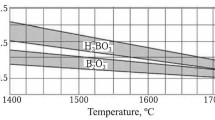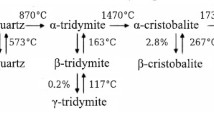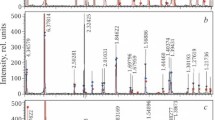The properties and wear resistance of induction furnace linings made from Karelian vein quartz during the smelting of copper-based alloys are studied. The wear mechanism of a vein quartz lining is demonstrated.
Similar content being viewed by others
Avoid common mistakes on your manuscript.
Introduction
Currently in our country and overseas for lining induction furnaces there is extensive use of acid lining mixes. As a lining filler during melting cast iron and nonferrous alloys based on copper apart from acid lining materials there is use of fired kyanite, corundum, high-alumina chamotte, magnesite, aluminum and magnesium silicates, and zircon- containing materials. In order to line induction furnaces there may be use of mixes of mullite, mullite-quartz, forsterite, and spinel compositions.
Preparation of a lining of induction furnaces from vein quartz in contrast to crystalline quartz is connected with some difficulties. Vein quartz is slowly converted into a low-density modification since normally it has a single-crystal structure in contrast to crystalline quartzite consisting of fine grains (0.1 – 0.3 mm). Due to a high silica content and low (0.25%) content in vein quartz a lining based upon it should exhibit a high temperature for the start of deformation under load of 0.2 MPa.
During firing a crucible lining of polycrystalline vein quartz it should crack, especially at high temperature (≥1500°C) [1]. In this case it is necessary to consider the specific behavior of a crucible during heating in order to obtain dense and strong refractory material, to select correctly the grain size composition of a lining mix, as for preparation of dinas, and also the type and amount of sintering additive and firing regime.
State of the Question
Acid refractory materials used in melting cast iron, copper, and alloys based upon it, in induction channel and crucible furnaces have been studied by domestic and overseas scientists [1,2,3,4,5,6,7,8]. In induction furnaces for melting cast iron it is preferred to prescribe a quartz mix that as a result of growth during inversion of quartz there is no shrinkage within them, and consequently crack formation, being a reason for removal of a lining from operation. For lining induction furnaces only those quartzites are suitable that during quartz inversion retain strength and density.
High-alumina linings have been studied after melting oxygen- free copper in channel induction furnaces AYaKS and ILK-6 [3], and also a disthene-silimanite mix with addition of corundum during melting synthetic cast iron in 6-ton industrial frequency furnaces [7], and a magnesia lining mix with addition of corundum during copper [4]. It has been established [3] that wear of high-alumina refractory during melting oxygen-free copper proceeds as a result of gradual impregnation of a lining by copper oxides causing breakdown of the mullite crystal structure. In this case there is formation of glass and corundum, which react with copper oxides forming cupric and cuprous oxide aluminates concentrated within a lining transition zone.
The aim of the present study is selection of grain size and substance compositions for lining mixes made from vein quartz of local deposits, type and amount of sintering additives, and crucible firing regimes in order to provide stable operation of an induction furnace lining. It was necessary to explain reasons for the wear of induction furnace crucible acid lining during melting nonferrous alloys based on copper.
During a study vein quartz from the Pervoural’sk quartzite of the Karaul Mountain deposit was compared. Pervoural’sk quartzites are used extensively in the production of dinas and in order to line induction furnaces during melting cast iron and channel induction furnaces melting oxygen- free copper and alloys based on copper [2 – 4]. In a number of overseas countries research has been conducted for use of local quartzite raw materials with the aim of refraining from obtaining imported lining mixes from Russia and supply of their own product. In Germany quartzite deposit of the Grosskorbet deposit has been studied. Quartzite has been used with addition of boric acid or clay in order to provide sufficient sintering if the lining working layer without a marked reduction in refractoriness [6]. However, the dependence of lining life on binder content has not been established.
In quartzite mixes of Pervoural’sk quartzite and vein quartz fraction finer than 1.0 mm an increase is noted in the content of iron oxides evidently due to milling metal, which is confirmed by material magnetic separation. The size of Pervoural’sk quartzite grains varies within the limits of 0.05 – 0.2 mm. As a result of phase transformations proceeding within a vein quartz lining and Pervoural’sk quartzite during service (Fig. 1) it becomes unstable towards thermal shock. Interaction of refractory material with melt reagents in an induction furnace depends on a number of factors, primarily on technology for performing a metallurgical process. For induction melting there is typically regular control of the melting temperature, movement of liquid metal due to electromagnetic mixing. The slag temperature is somewhat lower than the metal temperature.
Lining of a laboratory crucible with addition of 1.5% boric acid (×80). Large quartz grains are broken by cracks. The space between quartz grains is filled with glass phase with separation within its composition of tridymite inclusions after melting tin bronze and silica brass (a), tridymite and cristobalite after melting aluminum and nickel bronze (b ).
Research Procedure
The grain size composition of a lining mix of vein quartz according to recommendations of I. S. Kainarskii [1] includes grains with a size of not more than 2 mm; the content of grain sizes less than 0. 5 mm comprised 50 – 55%, including 32 – 38% less than 0.1 mm and 23 – 25% less than 0.071 mm. a crucible was fired at 1450°C with holding at the final temperature for 3 h. In order to determine the optimum of sintering additive to a vein quartz lining of improved grain size composition the upper part of a crucible in an ILT-1 furnace was made in four parts over a height of 150 mm below the pouring nose level. Each part was lined with a mix of vein quartz with different sintering additive (boric acid). Metal melting temperature (1280 – 1300°C) was maintained for 1 h after which the furnace was switched off and metal was frozen in the furnace. Then the metal melting cycle was repeated, taking the metal temperature to 1300°C, holding the alloy at this temperature for 1 h, after which the furnace was cooled gradually to solidify the metal. The metal heating cycle with exposure at constant temperature and the furnace cooling cycle comprised about 4 h.
After conducting test melts samples were selected from a lining for revealing the mechanism of copper and alloy penetration into its base in refractory material. The specimens selected were cut with a diamond disk. Proceeding from the data obtained for metal resistance a sintering additive was selected for the hearth and walls of a crucible in an amount of 1.6%, and also for the upper part of a crucible (2.5%).
Research Results
The properties of lining specimens made from vein quartz with addition of 1.6% boric acid after firing at 1450°C for 3 h: porosity 24%, temperature for the start of deformation under a load of 0.1 MPa 1570°C, ultimate strength in compression 16 MPa. A reduction in the amount of coarse grains, replaced by finely milled grains in an amount up to 32% led to a reduction in porosity and an increase in crucible lining strength.
1.0 – 1.5% boric acid was added to a lining mix of Pervoural’sk quartzite with grain size up to 4.0 mm. This amount of additive provided quartzite mix sintering. The properties of lining specimens of Pervoural’sk quartzite: refractoriness 1750°C, density 2.517 g/cm3, apparent density 1.85 g/cm3, open porosity 22.21%, ultimate strength in compression 14.5 MPa, linear growth (1450°C, 2 h) 1.25%, and temperature for the start of deformation under a load of 0.2 MPa 1470°C.
It has been established that the main reason for lining wear is a reduction in refractoriness caused by glass phase formation at the molten metal and slag boundary with refractory material. Softening of the lining working layer facilitates a reduction in strength and gradual wash-out if refractory particles from a crucible wall by molten metal and slag under action of electrodynamic forces during service. Crucible wall thinning, and stresses arising within quartz grains ad within the whole crucible quartzite lining due to allotropic transition of quartz into low density modification causes formation of cracks and pores with subsequent filling of them by metal. Metal oxidation within cracks and pores of a lining leads to a change in volume and development of additional stresses within refractory.
Microscope studies showed profound regeneration of quartzite to tridymite during melting cathode copper, and tin and lead bronzes, silica brasses (temperature according to the melting production process 1100 – 1250°C, and to cristobalite and tridymite during melting aluminum and nickel bronzes when the working temperature in a furnaceincreases to 1350°C. The degree of quartz regeneration into tridymite and cristobalite increases from the cold side of a lining towards its more heated zone. Quartz thermal transformation, occurring during crucible lining service, leads to a change in lining volume, cracking of individual quartz grains, and the lining as a whole.
During melting cathode copper in the contact zone there is formation of pyroxene and glass. Significant separation of glass phase is also observed in contact and in working zones of the lining after melting nickel bronze. An increase in the amount of glass facilitates a reduction in lining refractoriness in these zones, and metal and slag heating cause refractory softening, and circulation of molten metal and slag under action of electrodynamic forces causes wash-out from refractory material crucible walls.With crack development in a lining there is possible metal penetration towards the inductor winding. Breakdown of a quartz lining during alloys based on copper and cathode copper includes a reduction in crucible thickness. During melting aluminum bronze growth of a crucible lining due to corundum formation that separates on crucible walls.
Conclusion
Lining mixes of Karelian vein quartz and Pervoural’sk quartzite have been studied during melting copper and alloys based upon it in induction furnaces.
Optimum (substance and grain size) compositions have been selected for lining mixes with choice of sintering additives. Laboratory studies have been conducted on lining specimens with a selection of compaction pressure and firing regimes.
Under laboratory conditions tests have been conducted for linings in an IST-0.063 induction furnace with a capacity of 60 kg, and for industrial approval of the refractory it was performed in a crucible induction furnace of induction frequency ILT-1 with a capacity of 1 ton.
A study of the effect of melting different alloys on the phase transition of quartz within a lining composition has been studied. It has been established that crucible lining wear after melting cast iron and nonferrous alloys based copper proceeds most intensely in the furnace slag belt.
Testing of lining mixes apart from melting cast iron were conducted in an induction furnace of the nonferrous metal casting workshop of the Tyazhbummash Petrozavodsk Plant. Test showed that during melting bronzes (BrOTsS10-2,BrAZh9-4 l, BrOTsS-5-5-5) and brass (LK80 3l) in an ILT-1 furnace the life of a test lining made from vein quartz was from 107 – 115 melts, and from Pervoural’sk quartzite it was from 90 – 112 melts for a campaign. The main factors have been established for refractory wear of Pervoural’sk quartzite and Karelian quartz during melting nonferrous alloys based on copper.
The suitability has been established for Karelian vein quartz for lining induction melting furnaces for alloys based on copper. Selection of vein quartz lining mix and the firing temperature achieved favorable results for lining wear resistance. Therefore, the lining wear rate depends to a significant extent on changes in refractory structure adjacent to the crucible working surface, and with an increase in amount of liquid phase, and also the depth propagation of these changes worsening refractory material properties.
References
I. S. Kainarskii, Dinas [in Russian], Metallurgizdat, Moscow (1961.
M. N. Kaibicheva, “Comparative study of the properties of domestic and Swedish quartzite mixes for industrial furnaces,” Trudy VostIO, No. 10, 199 – 206 (1970).
I. Ya. Prohorova, “Study of the service of refractories in industrial channel furnaces melting copper and alloys based on copper,” Author’s Abstr. Diss. Cand. Techn. Sci., Leningrad (1979).
T. A. Aleksandrova, I. Ya. Prokhorova, and O. V. Novikova, “Lining high-frequency vacuum induction furnaces for melting copper and alloys based upon it,” Ogneupory, No. 3, 33 – 36 (1972).
A. I. Avgustinik, A. S. Zavertkin, and A. V. Ryleev, “Refractory materials for lining induction furnaces. Scientific production association Tsellulozmash,” Ogneupory, No. 5, 39 – 42 (1972)
R. Rasch, “Quarzit in Induktionsoffenstampfmassen,” Giesserei, 48(16), 457 – 461 (1961).
V. S. Shumikhin, P. P. Luzan, and M. V. Zhel’nis, Synthetic Cast Iron [in Russian], Naukova Dumka, Kiev (1971).
V. V. Shchitsov, V. A. Perepilitsyn, E. E. Grishenkov, and A. S. Zavertkin, “Study of Pervoural’sk and Karelian quartzites for lining induction crucible furnaces,” Novye Ogneupory, No. 6, 37 – 45 (2002).
Author information
Authors and Affiliations
Corresponding author
Additional information
Translated from Novye Ogneupory, No. 9, pp. 55 – 58, September, 2019.
Rights and permissions
About this article
Cite this article
Zavertkin, A.S. Use of Vein Quartz for Lining Induction Furnaces during Melting Copper-Based Alloys. Refract Ind Ceram 60, 468–471 (2020). https://doi.org/10.1007/s11148-020-00387-2
Received:
Published:
Issue Date:
DOI: https://doi.org/10.1007/s11148-020-00387-2







